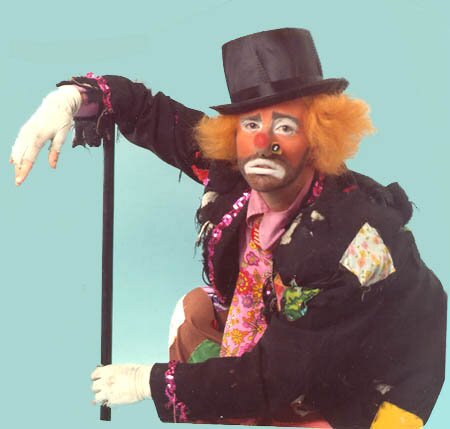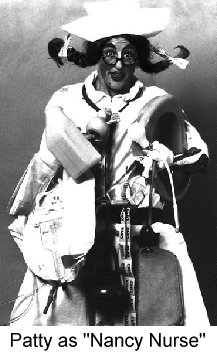
Patty Wooten presents ... 
Send In The Clowns! Part I
From Journal of Nursing Jocularity, Winter 1992, 2(4), pp 46-47.I got to go to Clown Camp!
Held in LaCrosse, Wisconsin, it was inspiring, informative, EXHAUSTING, and delightful. Anyone may attend, young or old, novice or professional.1 Two hundred clowns from all over gathered for this week-long infusion of study and practice. Each day we had activities from 8a.m. to 10p.m., and we had to choose from over 20 daily classes on various aspects of clowning. I wish I could have taken them all!
Some of the most exciting parts were those focused on the development and education of Caring Clowns - clowns who visit hospitals or nursing homes and practice therapeutic clowning.
Clowns have existed since the beginning of time. They have had different names in different societies, but all have served similar functions. Clowns have been recognized as having an important influence on the health of the community as well as on individuals. In some cultures, such as Hopi & Zuni, they have even participated directly in healing rituals-but that's another article.
As early as the middle ages, the philosopher Syddenham noted:
"The arrival of a good clown does more for the health of the village than twenty asses laden with drugs."
More recently, Norman Cousins upheld this evaluation by acknowledging the importance of faith, hope, confidence, laughter, joy, and festivity to offset the impact of negative emotions and to mobilize the 'will to live'.
Most of us are familiar with the circus or parade clowns and remember them as bold, bumbling, and noisy. In contrast, the caring clown working in a hospital or nursing home is gentle, soft, and empathetic. A good caring clown should be sensitive, be able to read non-verbal body language, and possess good listening skills.
Bedside clowning attempts to distract patients from their problems, help them forget their pain, and offer them an opportunity to watch or participate in some silliness. The goal is to afford the patient momentary release from personal burdens, to inspire joy, and to stimulate the will to live.
The court jester who served Queen Elizabeth I was described as:
" . . .a master of his faculty . . . He told the Queen . . . more of her faults than most of her chaplains and cured her melancholy better than all her physicians."2
Sharing in the belief that humor has healing capabilities, we find the caring clowns - a group of present-day jesters who use their clowning to help people in our modern courts of medicine.
Richard Snowberg and Janet Tucker are instructors for the "Caring Clown" program at Clown Camp and are active in their local hospitals and communities. (Richard has recently published a book on the subject3 and is also director of Clown Camp) These two people have inspired me and guided me in developing better skills and a more polished clown bedside manner.

 There are certainly more clown visiting programs than I have mentioned. (If you know of one, please tell me about it so I can add it to my growing list.)
There are certainly more clown visiting programs than I have mentioned. (If you know of one, please tell me about it so I can add it to my growing list.)